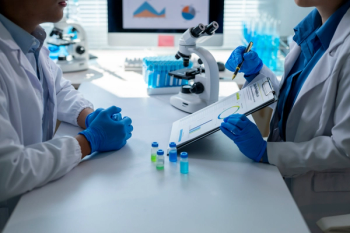
If FDA’s NDI Guidance Helps Level the Astaxanthin Playing Field, That’s Good, Says AstaReal
At SupplySide West, natural-astaxanthin supplier AstaReal spoke about how FDA’s NDI guidance could help level the playing field between competitors in the astaxanthin space.
Industry trade shows are more than just a place to see new company innovations; they also are a place to see who the competition is. At SupplySide West, one company, natural-astaxanthin supplier AstaReal (Burlington, NJ), spoke about how FDA’s new dietary ingredient (NDI) draft guidance could help level the playing field between competitors in the astaxanthin ingredient space.
Among the brighter spots in the August 11 revised version of the NDI draft guidance, FDA says that companies should not borrow another firm’s NDI data unless expressly authorized to do so by the original notifier. As the draft guidance explains, this means that if two firms supply similar or even identical ingredients, and one of those firms has already submitted an NDI notification for its ingredient, the other firm claiming to sell a similar or identical ingredient must still submit its own notification to show that its ingredient is also safe. It cannot borrow the original notifier’s data unless the original notifier grants permission to do so-which, in the case of competitors, would be highly unlikely.
Most industry leaders have hailed this aspect of the guidance, stating that it will prevent companies from unfairly riding the coattails of another company’s safety data. Back in August, Steve Mister, president and CEO of the Council for Responsible Nutrition,
I spoke to Joe Kuncewitch, national sales manager at AstaReal, about how his firm may benefit from this NDI provision in the astaxanthin industry, a category that has seen numerous competitors enter the market in recent years.
Kuncewitch questioned whether all of the companies competing in the astaxanthin market today have NDI notifications or Generally Recognized as Safe (GRAS) affirmation for their ingredients.
“Do they have an NDI [notification]? Do they have GRAS affirmation? I don’t know,” he said, noting that AstaReal has both of these. If they don’t, he said, “they’re just piggybacking off the good graces of folks like AstaReal, and I think FDA would turn an evil eye against that. One company gets the NDI, one company has the GRAS affirmation, one company has the science, one company has the approvals-and now all the other ones are going to pile on? That doesn’t seem fair in any kind of fight.”
Firms using Haematococcus pluvialis-derived astaxanthin in dietary supplements would need an NDI notification because the ingredient was not sold in the dietary supplements market prior to October 15, 1994, the cut-off date separating pre-DSHEA ingredients and NDIs.
AstaReal received a
Nutritional Outlook reached out to other natural-astaxanthin firms to confirm their own NDI status. BGG (Irvine, CA) provided documentation confirming its no-objections letter from FDA for AstaZine natural astaxanthin at a 12-mg maximum dose. And Cyanotech (Kailua-Kona, HI) also provided documentation confirming its BioAstin natural astaxanthin at a 12-mg maximum dose.
Nutritional Outlook reached out to two other natural-astaxanthin suppliers, Algatechnologies (Kibbutz Ketura, Israel) and Valensa (Eustis, FL), but did not receive definitive confirmation of these firms’ NDI status/dosages in time for publication.
Kuncewitch said he “hopes that’s the case” that FDA will enforce its “no piggybacking” provision and follow through on requiring firms to submit their own NDI notifications. Kuncewitch acknowledged the high cost that companies like his pay in order to file NDI notifications in the first place, including investing in requisite studies, preparing the notification, and hiring a consultant if necessary. “Getting an NDI is not as easy as just, ‘Oh, we’re going to get an NDI, folks,’” he said. “It took us mountains and mountains of research and papers and consultants and thousands and thousands of dollars to do this. We hire the best consultants in the world to look over our safety data. That’s the most important thing to FDA. We have studies showing that.”
For these reasons, Kuncewitch said he was happy to see these provisions written into the new NDI draft guidance. “Yes, I was happy, because on face value it seemed, okay, this is going to get the fakers, the cheaters, and those who are piggybacking off of our backs.”
A company also should refrain from allowing usage of its ingredient at a dose that is higher than an NDI notification allows, Kuncewitch said. “That’s kind of the gray area in the industry,” he said. “If some guy has [an NDI notification] at 4 mg, some guy has it at 5 mg, and one guy has it at 12 mg, can we all use it at 12 mg? I don’t know. That is the question, the conundrum that FDA needs to face and that this industry needs to challenge.”
All of this depends on how vigorously FDA follows its guidance during enforcement, however. “I think the new guidance is going to do well if FDA has teeth,” Kuncewitch said. “And that’s the thing. FDA’s going to need to do some enforcement. And, again, what’s the enforcement? Selective enforcement? A slap on the wrist? A warning letter? I don’t know, but I just think the room’s certainly big enough for everyone to take a share.”
He continued, “There’s a big pie of astaxanthin out there. The pie is maintaining its size; there’s just more slices being cut. Is that okay for us? Sure, we’re happy with competition. That’s what makes us grow, and that’s what makes the industry grow, and we’re ready for competition. That makes our customers hungry. We can handle competition. But what I think what we do need is fair competition. If the NDI guidance chooses fair competition, then I’m happy with it. Let’s see what happens.”
Also read:
Editor-in-Chief
Nutritional Outlook magazine
jennifer.grebow@ubm.com
Newsletter
From ingredient science to consumer trends, get the intel you need to stay competitive in the nutrition space—subscribe now to Nutritional Outlook.





